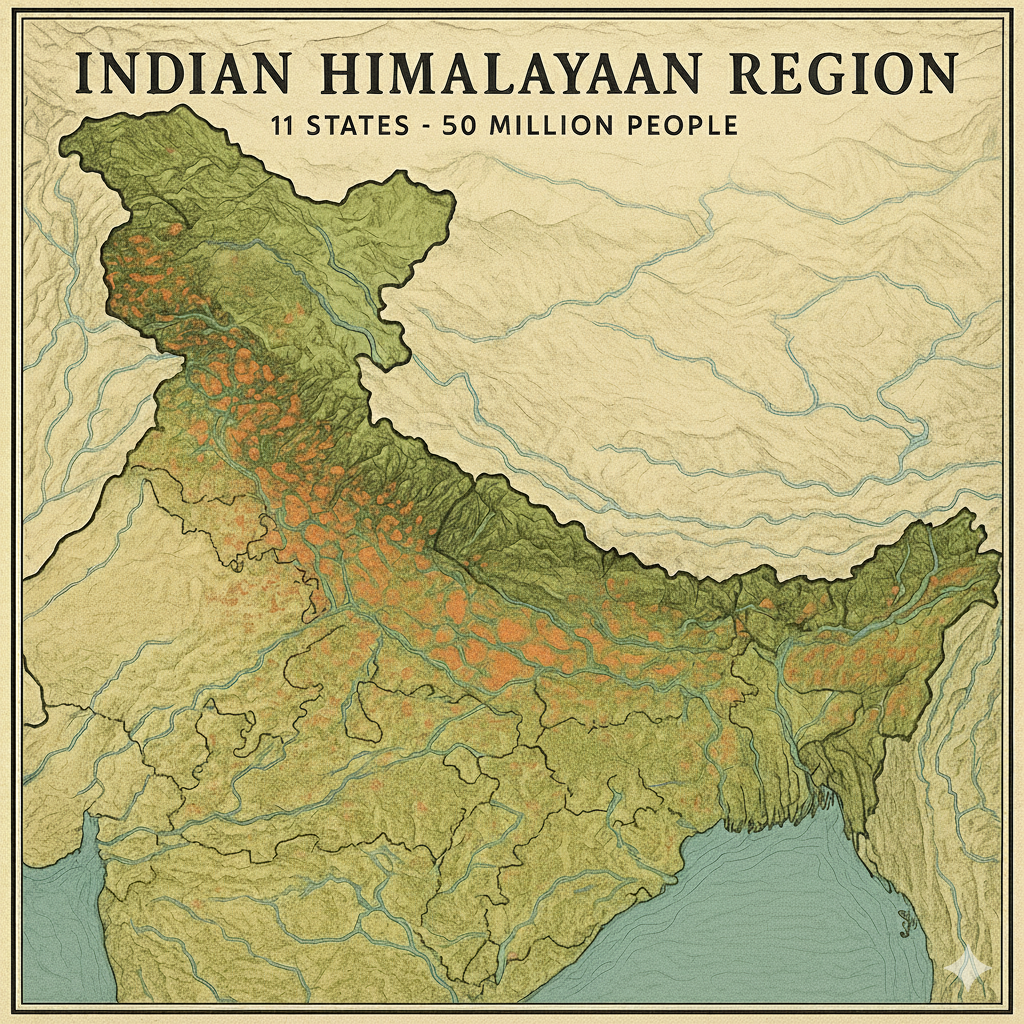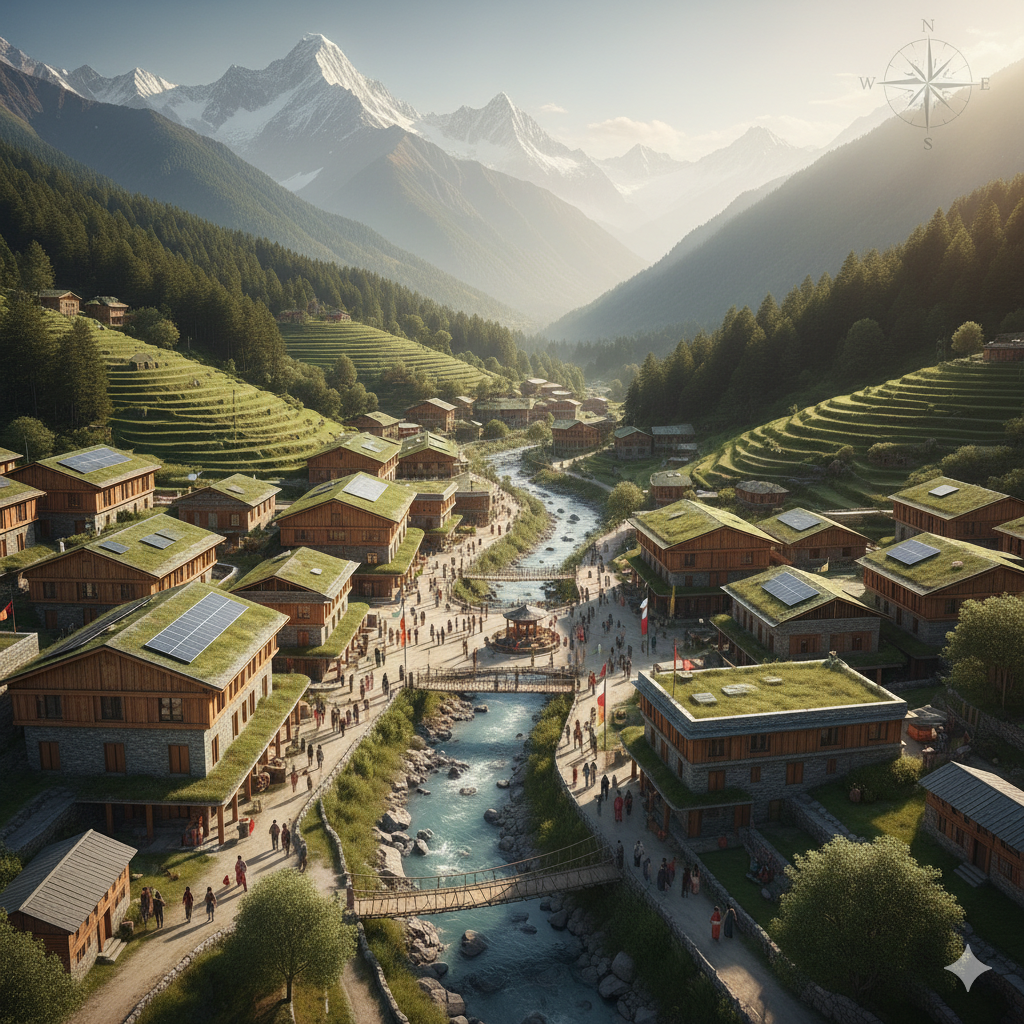Key Highlights
- Indian Himalayan Region spans 13 states/UTs housing 50 million people with over 40% urban growth (2011-21) creating unprecedented development pressure
- Tourism-driven stress exemplified by Manali where 8,000 residents host 70,000 daily visitors (1:650 ratio) exceeding carrying capacity thresholds
- Srinagar shows alarming urban sprawl with 75.6% built-up area increase and 25% water body loss (2000-2020) highlighting unsustainable growth patterns
- Severe governance crisis with 75% staffing shortage in city governments and only 15 executive officers managing 40+ urban bodies in Kashmir Valley
- NMSHE mission addresses climate vulnerability with ₹550 crore budget targeting ecosystem health monitoring and traditional knowledge integration
The Indian Himalayan Region (IHR), stretching across 13 states and union territories and housing nearly 50 million people, stands at a critical juncture in its development trajectory. With a decadal urban growth rate exceeding 40% (2011-2021) and towns like Srinagar witnessing a 75.6% increase in built-up area while losing 25% of its water bodies, the region exemplifies the urgent need for a paradigm shift in mountain urbanism. The application of plains-centric planning models to these ecologically fragile and geologically complex terrains has created unprecedented challenges, demanding a revolutionary approach that harmonizes development aspirations with environmental stewardship and cultural preservation in one of the world’s most sensitive ecosystems. niti.gov

The Himalayan Urban Challenge: Scale and Complexity
Demographic and Geographic Context
The Indian Himalayan Region encompasses a vast geographic expanse of 2,500 kilometers, representing 18% of India’s total geographical area while supporting 4% of the country’s population. This seemingly sparse distribution masks the reality of concentrated urban pressure in specific valleys and corridors where topographic constraints force development into narrow, ecologically sensitive zones.
Regional Coverage and Population Distribution:
- 13 States/UTs: Jammu & Kashmir, Ladakh, Uttarakhand, Himachal Pradesh, Arunachal Pradesh, Manipur, Meghalaya, Mizoram, Nagaland, Sikkim, Tripura, Assam, and West Bengal
- Total population: Nearly 50 million people with varying settlement patterns
- Urban growth trajectory: >40% decadal growth creating unprecedented urbanization pressure
- Strategic significance: International borders with China, Nepal, Bhutan, Myanmar, and Bangladesh
Tourism-Driven Urbanization Pressures
The tourism economy has become a double-edged sword for Himalayan towns, providing economic opportunities while creating unsustainable demographic pressures. Manali, for instance, with a permanent population of 8,000, transforms into a melting pot receiving over 70,000 visitors daily during peak season, creating a resident-to-tourist ratio of 1:650 that far exceeds carrying capacity thresholds.
Tourism Impact Statistics:
- Himachal Pradesh tourism growth: 7.9% annual average (2013-2023)
- Infrastructure strain: Tourist inflow exceeding resident population in key destinations
- Ecological footprint expansion: Manali’s footprint increased 25 times from 1971-1995
- Resource stress: Civic and consumer resources outstripped by floating population demands
Unique Characteristics of Himalayan Urbanism
Fragile Geography and Environmental Sensitivity
The Himalayan ecosystem presents unique urbanization challenges absent in plains regions, requiring specialized planning approaches that acknowledge the region’s geological instability and ecological fragility.
Geographic Constraints:
- Steep slopes and sharp gradients: Creating heterogeneous microclimates over short distances
- High seismic activity: Requiring earthquake-resistant construction techniques
- Landslide susceptibility: Demanding careful site selection and slope stabilization
- Glacial melt zones: Affecting water availability and flood risks
- Accelerated runoff and erosion: Due to steep terrain and precipitation patterns
Ecological Significance:
- Major river sources: Himalayan glaciers feeding perennial river systems supporting over 1.2 billion people downstream
- Biodiversity hotspot: Critical habitat for endemic species and ecosystems
- Carbon sink function: Forest ecosystems playing crucial role in climate regulation
- Water tower of Asia: Providing freshwater security for regional populations
Cultural Diversity and Indigenous Knowledge Systems
The IHR represents one of the world’s most culturally diverse regions, with indigenous and tribal communities maintaining traditional settlement patterns and architectural knowledge adapted to mountain environments over millennia.
Cultural Characteristics:
- Indigenous societies: Diverse ethnic communities with unique governance systems
- Traditional architecture: Kath-kuni style in Himachal Pradesh, dzong architecture in Arunachal Pradesh
- Sustainable practices: Time-tested methods for slope stabilization and resource management
- Knowledge erosion: Risk of losing traditional wisdom due to modernization pressures
Critical Challenges: The Urban Crisis in Mountain Towns
Institutional and Governance Weaknesses
Himalayan urban governance faces severe institutional constraints that fundamentally undermine effective city management and development planning.
Human Resource Crisis:
- 75% staffing shortage: City governments operating at only 25% of required human resource capacity
- Kashmir Valley example: Only 15 executive officers managing over 40 urban local bodies (excluding Srinagar Municipal Corporation)
- Capacity limitations: Planning institutions using inappropriate plains-based models
- Financial constraints: Low fiscal transfers compared to plains cities
Planning Model Inadequacy:
- State Town and Country Planning Acts: Mostly modeled on plains with inadequate mountain-specific provisions
- Smart Cities Mission: Limited Himalayan representation (Dehradun, Gangtok, Shimla) with insufficient mountain-specific guidelines
- Regulatory gaps: Absence of high-altitude building codes and slope-specific regulations
Environmental Degradation and Resource Stress
Uncontrolled urban expansion has led to systematic environmental degradation across Himalayan towns, with Srinagar serving as a stark example of unsustainable growth patterns.
Environmental Impact Indicators:
- Srinagar (2000-2020): 75.58% increase in built-up area, 25% decrease in water bodies
- Forest encroachment: Cities expanding into village commons, forest lands, and watersheds
- Waste management crisis: 90% of liquid waste discharged untreated into water bodies
- Resource depletion: Open spaces, wetlands, and biodiversity under severe pressure
Infrastructure Deficits:
- Water supply inadequacy: Chronic shortages during peak tourist seasons
- Sanitation breakdown: Overwhelmed sewage systems unable to handle population surges
- Solid waste management: Inadequate collection and disposal systems
- Transportation congestion: Narrow mountain roads unable to accommodate traffic volumes
Policy Framework and Institutional Response
National Mission for Sustaining Himalayan Ecosystem (NMSHE)
The National Mission for Sustaining Himalayan Ecosystem (NMSHE), launched in 2010 and formally approved in 2014 with a ₹550 crore budget, represents India’s comprehensive policy response to Himalayan environmental challenges under the National Action Plan on Climate Change (NAPCC). nihroorkee.gov
NMSHE Objectives and Implementation:
- Ecosystem health monitoring: Developing national capacity for continuous assessment of Himalayan ecosystem status
- Climate vulnerability assessment: Scientific evaluation of short and long-term climate change impacts
- Policy development: Evidence-based measures for sustainable mountain development
- Traditional knowledge integration: Studying community adaptation and coping mechanisms
- Regional cooperation: Fostering data exchange and policy coordination with neighboring countries
Mission Coverage and Scope:
- All 12 Himalayan states: Comprehensive geographic coverage across the IHR
- Department of Science & Technology: Nodal ministry with multi-stakeholder coordination
- State Climate Change Cells: 25 states and UTs supported for vulnerability assessment
- Research initiatives: Supporting climate-resilient agriculture and sustainable practices
Smart Cities Mission and Urban Development
Despite its transformative potential, the Smart Cities Mission has had limited penetration in the Himalayan region, with only select cities like Dehradun, Gangtok, and Shimla included, highlighting the need for expanded mountain-specific urban development programs.
Policy Gaps in Mountain Urbanism:
- Inadequate representation: Few Himalayan towns in flagship urban programs
- Generic guidelines: Absence of mountain-specific parameters in urban development schemes
- Funding disparities: Lower per-capita allocations compared to plains cities
- Technical expertise shortage: Limited specialized knowledge for high-altitude urban planning
Climate Change Vulnerability and Adaptation
NMSHE Climate Assessment Findings
Recent climate vulnerability assessments conducted under NMSHE reveal that the “greenest parts of India” are paradoxically the most vulnerable to climate change, with Himalayan states featuring prominently among high-risk regions.
Vulnerability Hotspots Identified:
- Eastern Himalayan states: Assam, Arunachal Pradesh, Mizoram ranking among most vulnerable
- Climate risk indicators: Rising temperatures, changing precipitation patterns, extreme weather events
- Downstream impacts: Affecting 1.2 billion people dependent on Himalayan river systems
- Adaptation priorities: Requiring immediate intervention for climate resilience imprintindia
Traditional Architecture and Climate Adaptation

Indigenous architectural traditions in the Himalayas represent centuries of climate adaptation and seismic resilience, offering valuable lessons for contemporary urban development.
Traditional Building Technologies:
- Kath-kuni architecture (Himachal Pradesh): Wood and stone construction providing earthquake resistance and thermal efficiency
- Dzong-style buildings (Arunachal Pradesh): Sloped roofs and elevated structures adapted to heavy rainfall and floods
- Stone masonry techniques: Local materials and traditional joints providing structural stability
- Passive climate control: Natural ventilation and solar orientation minimizing energy requirements
Way Forward: Paradigm Shift for Sustainable Mountain Urbanism
Mountain-Specific Planning Norms
Regulatory Framework Development:
- High-rise construction limits: Building height restrictions based on slope stability and seismic vulnerability
- Hazard zone mapping: Landslide and flood risk integration into city master plans
- Density controls: Population density limits based on carrying capacity assessments
- Green building mandates: Energy-efficient construction using local materials and traditional techniques
Institutional Reforms and Capacity Building
Governance Strengthening:
- Special mountain urban cadre: Trained personnel for high-altitude city management
- Enhanced fiscal transfers: Mountain-specific grants under Finance Commission recommendations
- Technical assistance: Specialized planning support for mountain municipalities
- Inter-state coordination: Regional planning bodies for watershed-based development
Community-Centric and Participatory Approaches
Indigenous Knowledge Integration:
- Traditional architecture promotion: Building codes incorporating indigenous techniques
- Community participation: Local involvement in urban planning and implementation
- Cultural preservation: Heritage conservation within development frameworks
- Benefit-sharing mechanisms: Ensuring local communities benefit from tourism and development
Global Learning and Best Practices
International Examples:
- Swiss Alps model: Strict zoning regulations, eco-tourism development, and resilient architecture
- Rocky Mountains (USA): Conservation-centric urban growth with environmental protection
- Scandinavian mountain towns: Sustainable development with community participation
- Bhutanese approach: Gross National Happiness incorporating environmental conservation
Technology and Innovation in Mountain Urbanism
Digital Solutions for Mountain Cities
Smart Technology Applications:
- GIS-based hazard mapping: Real-time monitoring of landslide and flood risks
- IoT sensors: Environmental monitoring for air quality, water resources, and weather patterns
- Satellite imagery: Urban sprawl tracking and green cover assessment
- Mobile governance: Digital service delivery overcoming geographic constraints
Sustainable Infrastructure Development
Climate-Resilient Infrastructure:
- Green buildings: Energy-efficient design using renewable energy sources
- Rainwater harvesting: Community-scale systems for water security
- Decentralized sewage treatment: Ecological treatment systems suitable for mountain terrain
- Disaster-resistant construction: Seismic design and slope stabilization technologies
Economic Sustainability and Livelihood Diversification
Sustainable Economic Models:
- Eco-tourism development: Low-impact tourism with community participation
- Organic agriculture: High-value crop production for premium markets
- Handicrafts and cultural tourism: Traditional skills commercialization
- Renewable energy: Hydroelectric and solar power development with local benefits
Building Resilient Mountain Communities
The transformation of Himalayan urbanism requires more than policy changes – it demands a fundamental reimagining of how development can coexist with ecological sensitivity and cultural authenticity. The 50 million people living in the IHR deserve cities and towns that are not just economically viable but also environmentally sustainable and culturally rooted.
Success will require:
- Political commitment to long-term sustainability over short-term economic gains
- Technical expertise in mountain-specific planning and engineering solutions
- Community engagement ensuring local ownership of development processes
- Financial mechanisms that adequately support mountain urban development
- Inter-regional cooperation for watershed-based and ecosystem-level planning
The urgency of this transformation cannot be overstated. With climate change accelerating and urbanization pressures mounting, the window for proactive intervention is rapidly closing. The choice facing the Indian Himalayan Region is stark: embrace a new paradigm of sustainable mountain urbanism or witness the irreversible degradation of one of the world’s most precious ecosystems.
The path forward demands courage to challenge existing development models, wisdom to learn from traditional knowledge, and innovation to create solutions that honor both human aspirations and environmental limits. Only through such transformative approaches can the Himalayan region achieve the sustainable urban future that its remarkable geography, rich culture, and vital ecosystem services deserve.
Mains Practice Qs
- “Himalayan urbanism cannot be a copy-paste model of plains urbanisation.” Critically analyse in the context of ecological vulnerability and governance challenges. (250 words)
- Discuss the impact of unplanned urban growth in the Himalayas on water security and disaster vulnerability. Suggest measures for sustainable mountain urbanism. (250 words)
- Evaluate the adequacy of existing schemes like Smart Cities Mission and Finance Commission transfers in addressing the unique challenges of Himalayan urban centres. What reforms are required? (250 words)








+ There are no comments
Add yours